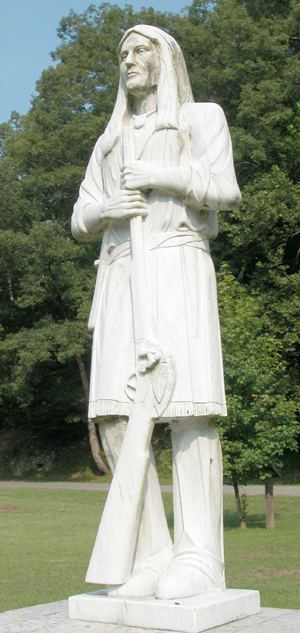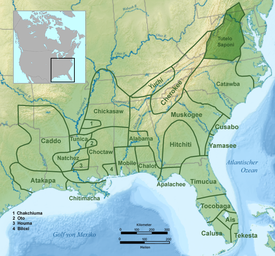The Waccamaw people were an Indigenous people of the Southeastern Woodlands, who lived in villages along the Waccamaw and Pee Dee rivers in North and South Carolina in the 18th century.

The Occaneechi Band of the Saponi Nation is a state-recognized tribe in North Carolina.

Siouan or Siouan–Catawban is a language family of North America that is located primarily in the Great Plains, Ohio and Mississippi valleys and southeastern North America with a few other languages in the east.
The Monacan Indian Nation is one of eleven Native American tribes recognized since the late 20th century by the U.S. Commonwealth of Virginia. In January 2018, the United States Congress passed an act to provide federal recognition as tribes to the Monacan and five other tribes in Virginia. They had earlier been so disrupted by land loss, warfare, intermarriage, and discrimination that the main society believed they no longer were "Indians". However, the Monacans reorganized and asserted their culture.
The Mosopelea, or Ofo, were a Siouan-speaking Native American people who historically lived near the upper Ohio River. In reaction to Iroquois Confederacy invasions to take control of hunting grounds in the late 17th century, they moved south to the lower Mississippi River. They finally settled in central Louisiana, where they assimilated with the Tunica and the Siouan-speaking Biloxi. They spoke the Ofo language, generally classified as a Siouan language.

The Saponi are a Native American tribe historically based in the Piedmont of North Carolina and Virginia. They spoke a Siouan language, related to the languages of the Tutelo, Biloxi, and Ofo.

The Eastern Siouan branch consists of various historical languages spoken by Siouan peoples of the Appalachian Plateau and Piedmont regions of present-day Virginia and the Carolinas. These languages are sometimes collectively referred to as Catawban, Tutelo, Tutelo-Saponi, or Yesah (Yesa:sahį). Eastern Siouan languages were historical spoken by the Monacan Indian Nation, Haliwa-Saponi, Catawba/Iswa, Occaneechi, and Waccamaw peoples. They possibly represent a dialect continuum with Ohio Valley Siouan languages. The Catawban family is a branch of the larger Siouan a.k.a. Siouan–Catawban family.

The Manahoac, also recorded as Mahock, were a small group of Siouan-language Native Americans in northern Virginia at the time of European contact. They numbered approximately 1,000 and lived primarily along the Rappahannock River west of modern Fredericksburg and the Fall Line, and east of the Blue Ridge Mountains. They united with the Monacan, the Occaneechi, the Saponi and the Tutelo. They disappeared from the historical record after 1728.

The Cheraw people, also known as the Saraw or Saura, were a Siouan-speaking tribe of Indigenous people of the Southeastern Woodlands, in the Piedmont area of North Carolina near the Sauratown Mountains, east of Pilot Mountain and north of the Yadkin River. They lived in villages near the Catawba River. Their first European and African contact was with the Hernando De Soto Expedition in 1540. The early explorer John Lawson included them in the larger eastern-Siouan confederacy, which he called "the Esaw Nation."

The Occaneechi are Indigenous peoples of the Northeastern Woodlands whose historical territory was in the Piedmont region of present-day North Carolina and Virginia.
The Honniasont were a little-known Indigenous people of the Northeastern Woodlands originally from eastern Ohio, western Pennsylvania, and West Virginia. They appear to have inhabited the upper Ohio River valley, above Louisville, Kentucky.

Fort Christanna was one of the projects of Lt. Governor Alexander Spotswood, who was governor of the Virginia Colony 1710–1722. When Fort Christanna opened in 1714, Capt. Robert Hicks was named captain of the fort and relocated his family to the area. His homestead Hicks' Ford is located near the municipality of Emporia in Greensville County, VA. The fort was designed to offer protection and schooling to the tributary Siouan and Iroquoian tribes living to the southwest of the colonized area of Virginia. Located in what became Brunswick County, Virginia, near Gholsonville, the fort was completed in 1714 and enjoyed three successful years of operation as the westernmost outpost of the British Empire at the time, before being finally closed by the House of Burgesses in 1718. However, the Saponi and Tutelo continued to live on the allotted land, 6 miles square, into the 1730s and 1740s.

The Mingo people are an Iroquoian group of Native Americans, primarily Seneca and Cayuga, who migrated west from New York to the Ohio Country in the mid-18th century, and their descendants. Some Susquehannock survivors also joined them, and assimilated. Anglo-Americans called these migrants mingos, a corruption of mingwe, an Eastern Algonquian name for Iroquoian-language groups in general. The Mingo have also been called "Ohio Iroquois" and "Ohio Seneca".
Nikonha, also known as Waskiteng and Mosquito, was known as the last full-blooded speaker of Tutelo, a Virginia Siouan language. He is reported to have been around 106 years old when he died at Six Nations of the Grand River First Nation, Ontario in 1871, where his people had migrated with the Cayuga during the American Revolutionary War.

Tutelo, also known as Tutelo–Saponi, is a member of the Virginian branch of Siouan languages that were originally spoken in what is now Virginia and West Virginia in the United States.

The protohistoric period of the state of West Virginia in the United States began in the mid-sixteenth century with the arrival of European trade goods. Explorers and colonists brought these goods to the eastern and southern coasts of North America and were brought inland by native trade routes. This was a period characterized by increased intertribal strife, rapid population decline, the abandonment of traditional life styles, and the extinction and migrations of many Native American groups.
The Sewee or "Islanders" were a Native American tribe that lived in present-day South Carolina in North America.

The Keyauwee Indians were a small North Carolina tribe, native to the area of present day Randolph County, North Carolina. The Keyauwee village was surrounded by palisades and cornfields about thirty miles northeast of the Yadkin River, near present day High Point, North Carolina. The Keyauwee village was vulnerable to attack, so the Keyauwee constantly joined with other tribes for better protection. They joined with the Tutelo, Saponi, Occaneechi, and the Shakori tribes, moving to the Albemarle Sound with the last two for a settlement that would later be foiled. The Keyauwee would move further southward along with the Cheraw and Peedee tribes, close along the border of the two Carolinas, where they conducted deerskin trade with Charleston traders and allied with the Indian neighbors in the Yamassee War. Eventually, their tribe name vanished from historical records, and with time, they were absorbed by the Catawba tribe.

The Indigenous peoples of Maryland are the tribes who historically and currently live in the land that is now the State of Maryland in the United States of America. These tribes belong to the Northeastern Woodlands, a cultural region.
Coreorgonel was an 18th-century Native American village in what is now Tompkins County, New York. The name has been translated as "Where we keep the pipe of peace."











